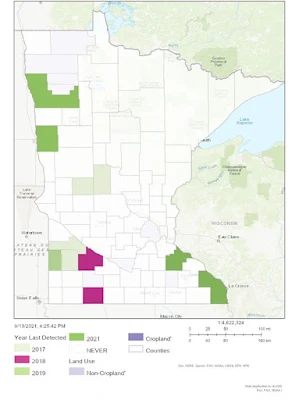Jared Goplen, Extension educator-crops and Debalin Sarangi, Extension weed specialist
As we approach harvest this year, be on the lookout for Palmer amaranth, September's Weed of the Month. Palmer amaranth is on Minnesota’s prohibited noxious weed and seed list with the intention to eradicate it before it becomes widely established in the state. Now is a good time of the year to scout for it, when mature Palmer amaranth plants are easier to distinguish from other closely-related pigweeds like waterhemp.
Interactive map of Palmer amaranth's distribution in Minnesota: https://z.umn.edu/Palmer-amaranth-status-MN
 |
| Palmer amaranth in a Tennessee field. Note the long terminal seedhead. |
Identification is key
Palmer amaranth is closely related to other amaranth (pigweed) species and it can be challenging to differentiate between them during the early vegetative stages. When scouting for Palmer amaranth at this time of year, be on the lookout for pigweeds with these distinguishing characteristics:- Look for long, terminal seedheads or pollen heads, up to 2-3 feet long, which are usually longer than other pigweed species.
- Seed heads (on female plants) have spiny bracts which are sharp when touched. Pollen-producing male flowers are long as well, but do not have spiny bracts.
- Look for long petioles. The petiole length of Palmer amaranth is typically longer than the leaf blade.
- Plants are smooth with no hairs on stems or leaves. In Minnesota, the only other commonly-occurring pigweed species without hairs is waterhemp.
Other scouting tips
 |
| Current distribution map and year that Palmer amaranth was first detected in Minnesota. |
- Look for rapid regrowth in areas that may have been cut or mowed earlier this year. Palmer amaranth tends to have a faster growth rate than other pigweed species, especially during hot summer weather.
- Spend extra time scouting areas where contamination is more likely, including fields seeded to native plantings or cover crops, or in fields that have a history of manure from livestock that were fed imported feed ingredients like cottonseed, sunflower screenings, sorghum, or purchased hay.
- In some cases, Palmer amaranth has maintained its green color slightly longer in the fall compared to waterhemp in Minnesota. This can be a useful tip in finding Palmer amaranth later into the fall, or even from the combine seat.
Interactive map of Palmer amaranth's distribution in Minnesota: https://z.umn.edu/Palmer-amaranth-status-MN
Reporting Process
If you suspect the presence of Palmer amaranth, the MDA and University of Minnesota Extension suggest the following reporting process:- Take pictures of the plant(s) in question. Pictures should include clear visibility of the whole plant, a close-up of the leaf and where it attaches to the stem, the flower head, and a leaf with the petiole folded over.
- Contact U of MN Extension, or MDA immediately and provide the pictures. Please include a phone number where you can be reached.
- It's preferable to leave the plants in the field until MDA or U of MN can get to the location to verify the plant and collect genetic material for confirmation. Some Palmer amaranth is fairly straight-forward to identify from pictures, but it is still important to get genetic confirmation. If plants have already been hand-pulled, collect at least five leaf samples from each plant, place in a Ziploc bag, and refrigerate until you contact the U of MN or MDA.
Key Palmer amaranth reporting contact
- Arrest the Pest – Web: http://www.mda.state.mn.us/plants-insects/arrest-pest
- Email: arrest.the.pest@state.mn.us (visit website for information to include)
- Phone: 1-888-545-6684


Comments
Post a Comment